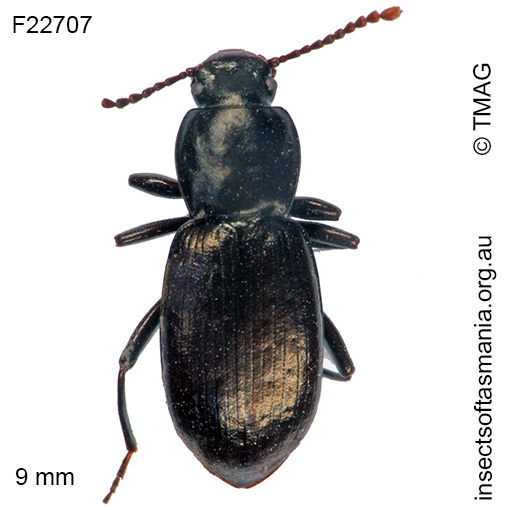
Diemenoma commoda (a species of darkling-beetle)
Basis for Tasmanian occurrence
Semmens, T.D., McQuillan, P.B. & Hayhurst, G. (1992). Catalogue of the Insects of Tasmania. Government of Tasmania: Department of Primary Industry, 104 pp. (as Adelium commodum)
TMAG collections
Classification
Order: Coleoptera
Suborder: Polyphaga
Superfamily: Tenebrionoidea
Family: Tenebrionidae
Subfamily: Lagriinae
Tribe: Adeliini
Morphology
Typical length (mm): 9
Flightedness: functionally flightless
Ecology
Assumed larval feeding: wood-feeder
Association with dead wood or old trees: obligately saproxylic
Ecological attributes: — Affiliated with older trees (Harrison, 2007) — Found under large logs (Grove et al., 2006) — May occupy logs or trunks of Eucalyptus obliqua, at least temporarily, since found having emerged within six years of felling (Grove et al., 2009).
Collection method(s) for TMAG material: — Emergence trapping from log of Eucalyptus obliqua — Hand collection (substrate not specified) — Hand collection from under log of Eucalyptus sp. — Knockdown fogging of canopy of Nothofagus cunninghamii — Malaise trapping — Pitfall trapping.
Source ecological literature:
Grove, S.J. et al. (2006). What lives under large logs in Tasmanian eucalypt forest? Tas. Nat. 128: 86-93.
Grove, S. et al. (2009). A long-term experimental study of saproxylic beetle … succession in Tasmanian Eucalyptus … logs… In: Fattorini, S. (Ed.), Insect Ecology and Conservation. Research Signpost, pp. 71-114.
Taylor, R.J. (1990). Occurrence of log-dwelling invertebrates in regeneration and oldgrowth wet sclerophyll forest in southern Tasmania. Pap. Proc. Roy. Soc. Tas. 124: 27-34.
Yee, M. (2005). The ecology and habitat requirements of saproxylic beetles native to Tasmanian wet eucalypt forests: potential impacts of commercial forestry practices. PhD thesis, Univ. of Tasmania, Hobart.

